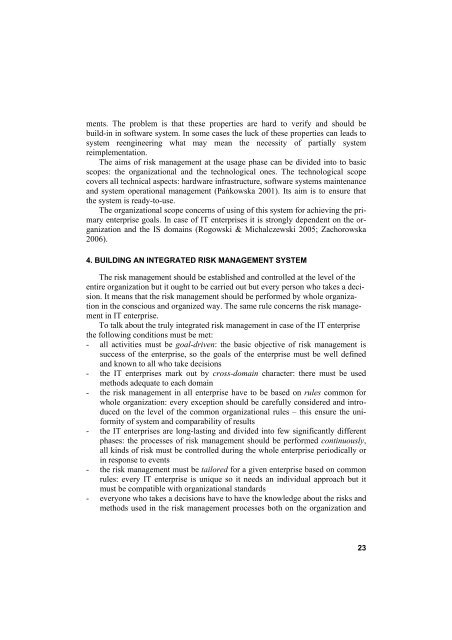INFORMATION SYSTEMS IN MANAGEMENT V - SGGW
INFORMATION SYSTEMS IN MANAGEMENT V - SGGW
INFORMATION SYSTEMS IN MANAGEMENT V - SGGW
You also want an ePaper? Increase the reach of your titles
YUMPU automatically turns print PDFs into web optimized ePapers that Google loves.
ments. The problem is that these properties are hard to verify and should be<br />
build-in in software system. In some cases the luck of these properties can leads to<br />
system reengineering what may mean the necessity of partially system<br />
reimplementation.<br />
The aims of risk management at the usage phase can be divided into to basic<br />
scopes: the organizational and the technological ones. The technological scope<br />
covers all technical aspects: hardware infrastructure, software systems maintenance<br />
and system operational management (Pańkowska 2001). Its aim is to ensure that<br />
the system is ready-to-use.<br />
The organizational scope concerns of using of this system for achieving the primary<br />
enterprise goals. In case of IT enterprises it is strongly dependent on the organization<br />
and the IS domains (Rogowski & Michalczewski 2005; Zachorowska<br />
2006).<br />
4. BUILD<strong>IN</strong>G AN <strong>IN</strong>TEGRATED RISK <strong>MANAGEMENT</strong> SYSTEM<br />
The risk management should be established and controlled at the level of the<br />
entire organization but it ought to be carried out but every person who takes a decision.<br />
It means that the risk management should be performed by whole organization<br />
in the conscious and organized way. The same rule concerns the risk management<br />
in IT enterprise.<br />
To talk about the truly integrated risk management in case of the IT enterprise<br />
the following conditions must be met:<br />
- all activities must be goal-driven: the basic objective of risk management is<br />
success of the enterprise, so the goals of the enterprise must be well defined<br />
and known to all who take decisions<br />
- the IT enterprises mark out by cross-domain character: there must be used<br />
methods adequate to each domain<br />
- the risk management in all enterprise have to be based on rules common for<br />
whole organization: every exception should be carefully considered and introduced<br />
on the level of the common organizational rules – this ensure the uniformity<br />
of system and comparability of results<br />
- the IT enterprises are long-lasting and divided into few significantly different<br />
phases: the processes of risk management should be performed continuously,<br />
all kinds of risk must be controlled during the whole enterprise periodically or<br />
in response to events<br />
- the risk management must be tailored for a given enterprise based on common<br />
rules: every IT enterprise is unique so it needs an individual approach but it<br />
must be compatible with organizational standards<br />
- everyone who takes a decisions have to have the knowledge about the risks and<br />
methods used in the risk management processes both on the organization and<br />
23


